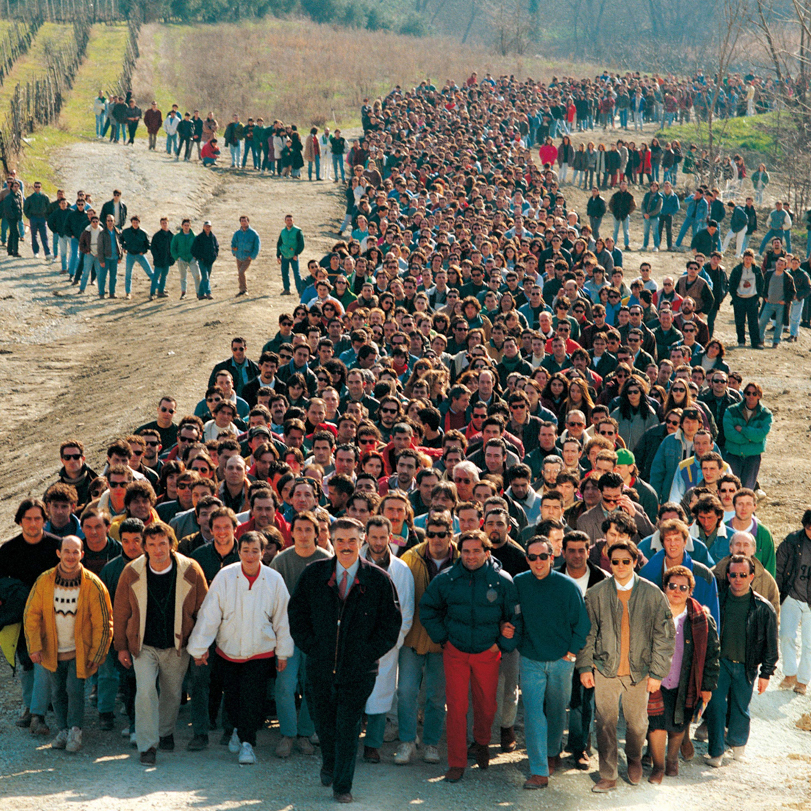“You can come, but if you leave, there’s no coming back.” This is one of the countless half-truths typical of Vincenzo Muccioli, the charismatic founder of San Patrignano, a rehab center in Italy’s Emilia-Romagna region that’s been around since the 1970s. It’s a half-truth because, for the most part, San Patrignano guests were not actually allowed to leave. It’s also the type of thing Muccioli is caught saying over and over again in SanPa: Sins of the Savior, Netflix’s first original Italian docuseries, which tracks the rise and precipitous fall of this larger-than-life personality.
Muccioli founded San Patrignano in the midst of Italy’s heroin crisis, and as the state became increasingly helpless in combating it, Muccioli became a sort of chosen figure. He seemed to be the only person with a solution to the drug epidemic, one that traded psychotropic pills for a community and a trade—cooking, mechanics, wine production, medicine.
Addicts lined up outside the commune’s gates for a chance to get in. And Muccioli’s popularity skyrocketed. Paparazzi began following him around; Italy’s celebrities sent their kids to San Patrignano; and his project was heavily financed by the rich, including Gian Marco and Letizia Moratti, heirs to an oil fortune.

Then came stories of kidnapping, suicide, and murder. Muccioli went from well-intentioned benefactor to cult leader, Italian-style, employing Mafia tactics of deputies, money-laundering, and threats. What had started off as a hippy oasis transformed into a strict program where violence ruled—orders passed down from the top. All of this makes for a gripping series asking the polarizing question: How far can one go under the pretense of doing good?
He seemed to be the only person with a solution to the drug epidemic, one that traded psychotropic pills for a community and a trade.
But the series isn’t telling the whole story. San Patrignano is still in business today, long after Muccioli’s mysterious death, in 1995. And largely omitting the success stories both from then and now does a disservice to all that the center has achieved. Since the late 70s, San Patrignano has been home at different times to a staggering 27,000 recovering drug addicts. Letizia Moratti, who since served as Milan mayor and was just appointed as the region’s minister of health, tells me that 1,000 kids live there today. Most are minors, many of whom have, in the past, prostituted themselves for drugs. For those who need it, lodging, food, and care has always been free of charge.
“After San Patrignano, 92 percent of former patients find a job. Seventy-two percent stay off drugs—a statistic that is significantly higher than for any other rehab in the world,” Moratti says (though data on abstinence rates following drug treatment is difficult to compare). These ex–drug addicts, once a significant cost to the country, effectively become contributors to its G.D.P. “The United Nations has studied the community’s model to import it to other world countries,” Moratti continues. “So have universities all around the world, including Cornell University. My point is, if one wants to tell a true story, it should outline all of its parts.”
What effect will the series’s allegations have on today’s residents—and on their road to recovery? Many Italians are disappointed that this exemplary institution has been smeared in the eyes of the greater world. Netflix portrays the story of San Patrignano as one of spectacular decline, but that’s just Muccioli. “Those young people are an example,” Moratti says, “both for Italy and for the world.”
SanPa: Sins of the Savior is available on Netflix
Elena Clavarino is an Associate Editor for AIR MAIL

